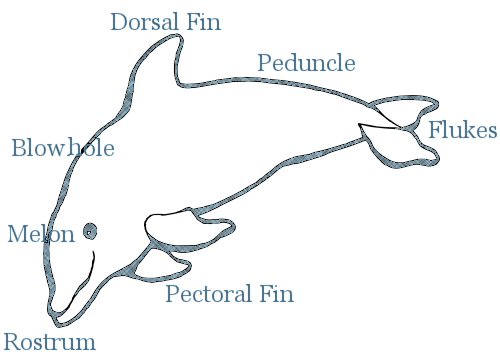
Anatomy of a Dolphin
Dorsal Fin
The Dorsal Fin is located on the back of many
marine animals. The purpose of the dorsal fin
is to stabilize the animal against rolling and
to assist with sudden turns. The dorsal fin
can vary in size and shape in different dolphin
species. Dorsal fins are absent on Northern
and Southern Rightwhale Dolphins, and some river
dolphin's dorsal fins are not prominent protrusions,
but more like bumps on their backs.
Blowhole
A blowhole is located in the top
of a the head of a cetacean, that allows the
animal to breathe in air. The blowhole is opened
by muscles upon surfacing and closed by the
pressure of water upon diving. Dolphins can
have one or two blowholes.
Melon
A dolphin's forehead is known
as their melon. The melon houses has small air
sacs, which are used to produce click vibrations
and vocalization sounds for echolocation and
communications.
Rostrum
The term rostrum comes from the
latin word, meaning beak. The rostrum is sensitive
to touch, and used by dolphins to feel objects
and for touch during social interactions.
Pectoral Fins
All cetaceans have developed pectoral
fins or flippers. Dolphins have well-developed
pectoral fins. The pectoral fins are made of
a combination of cartilage and bone. The pectoral
fins vary widely in shape, and from one species
of dolphin to another. The pectoral fins are
used for steering and stopping.
Flukes
A dolphin's fluke is his back
tail. The fluke is used for propulsion to propell
the dolphin forward through the water.
Peduncle
The peduncle is behind the dorsal
fin. The peduncle is very muscular and generates
the dolphins significant power, that allows
them to propel through the water at top speeds.

